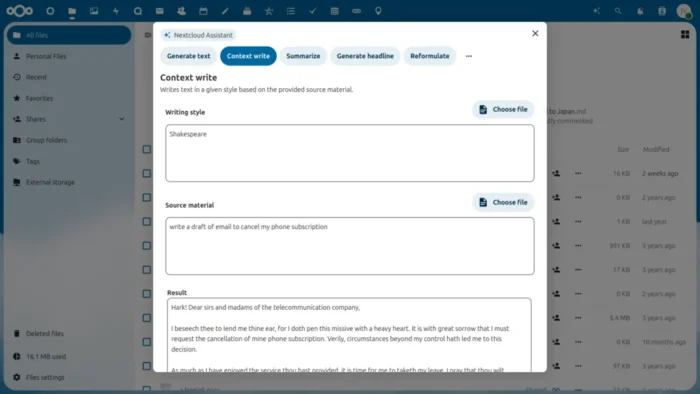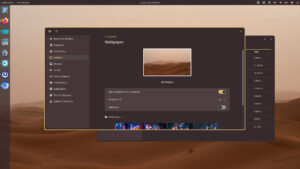Nextcloud has gone all-in on its generative AI Assistant. Version 2.0 has increased capabilities while giving users more fine grained control.

Considering that Nextcloud’s flagship open-source private cloud platform is only a couple of weeks away from the launch of Hub 8, you might think that its developers are too busy to work on other projects right now, but that’s not the case. It seems that the folks who work for the Germany-based company have been working overtime, and just last week announced the release of the latest and greatest version of Assistant, the generative AI platform that it incorporated into Nextcloud just last year.
“With a nearly complete overhaul of the user interface and how the Assistant works on the back-end, plus a ton of new, big features, we decided that this is the moment to call this the Assistant 2.0,” Jos Poortvliet, a company co-founder and its director of communications, said in a blog announcing the new release.
Included in the announcement was news of partnerships Nextcloud has formed with some EU-based AI as a service providers to make sure their cloud platforms work seamlessly with Nextcloud. This should be welcome news to European SMBs that would like to take full advantage of Assistant’s capabilities without having to break the bank purchasing GPU-laden servers to drive the AI.
Nextcloud’s AI-Juiced Customer/Employee Portal
When Nextcloud arrived on the scene in 2016 as a completely open-source fork of the open-core project ownCloud, it wasn’t particularly obvious that the platform would quickly morph from being what was primarily a file sharing platform, similar to Dropbox, to become a private cloud platform that offers many if not all of the capabilities that Fortune 500 companies include in their customer and employee portals.
These days the platform offers software for doing everything from project collaboration (where it competes with the likes of Office 365 and Google Docs), to video meetings (à la Zoom, Teams, Webex and such), and online calendaring and email (Outlook, Google Calendar). It also does these things well, with an eye on ease of use, best-of-breed security, and integration features that includes compatibility with competing platforms.
Also, for the last couple of releases it’s included AI in the mix with Assistant, which is integrated into all of Nextcloud’s capabilities. When I first told you about Assistant in Hub 6, it was already quite the useful helper. It could summarize text or email threads, change writing to be formal or relaxed, translate chat messages, and more. It was also privacy aware, which isn’t always the case when it comes to AI.
Since Assistant’s beginning, not only has its use has been optional, but administrators can also choose between several on-premises and SaaS AI engines such as ChatGPT, CoPilot, and the like. In addition, Nextcloud’s Ethical AI rating gives admins and users info on the privacy and data sovereignty implications of its options. As Poortvliet said in his write-up about Assistant’s latest and greatest, “Given that even the US Congress doesn’t trust ChatGPT or Microsoft CoPilot, there are good reasons to want control over the data sent to and from an AI service!”
What’s New in Assistant 2.0
The most notable new features in Assistant 2 are two related features called Context Chat and Context Write, with the first, according to Poortvliet, helping explain your data, either to your team or to your customers.
“Say you have a PDF with the manual of your new digital watch,” he offered as an example. “You’ll be able to ask the Assistant how to set it up or how to replace the battery. If your company has a nicely documented reimbursement process in its documentation, you can ask the Assistant questions about this process. This is an absolutely amazing ability!”
Context Chat also isn’t limited to working with data found in files. It can also be configured to use data in Nextcloud’s Mail, Calendar, Talk, and Deck features.
“You’ll then be able to ask ‘When do I have my next meeting with my boss?’ (from the Calendar), and ‘What tasks did she ask me to work on as high priority this week?’ (from Mail), or ‘Give me a summary of the status of project X’ (from Deck and chat perhaps),” he explained.
Context Write is the same, only different. It’s for letting Assistant rewrite something in a requested context, or style. This means it can be fed some data, given a sample of the wanted writing style, and used to help write some copy explaining a new product or service. Perhaps more importantly, it can also be used to help create online forms and the like that might be needed for a company’s website.

There have also been major changes on how users can work with AI from within Assistant. For example, now users can see a history; a list of earlier generated images; or even text or audio transcripts from within Assistant’s interface. Users can also create a new project based on previously used prompts. It’s also now possible to cancel a running operation if needed.
More importantly, administrators can now use outside AI models that have not been natively integrated into Nextcloud, which should be welcome news to organizations using Nextcloud that have been working on their own AI models. In addition, the new Assistant will also help IT teams take advantage of any supercharged hardware infrastructure they might be using (or want to use) to run Nextcloud.
“Especially for larger deployments, we have made it possible to run the LLM and other AI operations like Transcription and Context Chat on a separate server, using our new external app ecosystem for one-click, Docker-based deployments,” Poortvliet explained. “You can also now use a GPU for text generation, transcription, and context chat. This means transcribing an hour-long audio file could, on a CPU, take many minutes while taking only seconds on a GPU!”
Nextcloud’s EU-Based Ready for AI Cloud Deal
Obviously, to fully take advantage of all that AI capability you’re going to need some serious GPU-laden hardware, which means either heavy CaPex spending or turning to metered cloud solutions, which are easy to find until you start trying to keep your data in your home country, which government regulations are making increasingly necessary these days. For those of us in the States or for folks in China, sovereignty respecting AI as a service is pretty easy to find — but not so much for organizations in the EU, which has some of the strictest laws on keeping customer data in-country.
It turns out that Nextcloud has been working to address that issue too.
“We have been working closely with several major European hosting companies including IONOS and OVHcloud to integrate their upcoming AI-as-a-Service solutions,” Poortvliet said. “This will make them available to Nextcloud customers and users who wish to take advantage of the advanced AI functionalities in Nextcloud Hub but don’t wish to host AI services themselves. Several Nextcloud customers have expressed interest in these features and are preparing to or in the process of testing them.”
How to Kick the Tires
Taking Assistant 2.0 out for a test drive is drop-dead easy for those already running Nextcloud. It’s already been backported to Nextcloud Hub 7, meaning its fully available in the Nextcloud app store.
“All you need to do is update,” Poortvliet said.
“To run the AI locally, it’s easiest to use LocalAI,” he added. “A community container exists for our All-in-one, so users of the AIO can simply go to this page to learn more about adding extra containers and then enable the LocalAI container. Be sure to check out our documentation and ask questions in the forums.”
If you’re ready to take it to the next level and learn to use Assistant like a pro, you can register for a special one-hour webinar that Nextcloud will be presenting on April 18.
Christine Hall has been a journalist since 1971. In 2001, she began writing a weekly consumer computer column and started covering Linux and FOSS in 2002 after making the switch to GNU/Linux. Follow her on Twitter: @BrideOfLinux









